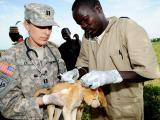Today the Centers for Disease Control and Prevention (CDC) released new data on rabies infections in the United States and said bats—and no longer raccoons—are the animal most likely to transmit the virus to humans.
Rabies is an almost-always fatal disease in humans, but treatment with post-exposure prophylaxis (PEP) that includes rabies vaccine and immune globulin prevents death if administered before symptoms begin.
In 2017 and 2018, an average of 55,000 Americans (range, 45,453 to 66,000) were treated for potential rabies exposure each year, with an average PEP cost of $3,800.
Dogs risk for international travelers
One to three Americans will die from rabies annually, with 59,000 deaths globally. For 98% of the world's rabies cases, dogs are the carriers of the virus, but canine variants of rabies have been eliminated from the United States since 2004 through the use of parenteral and oral rabies vaccines.
"Reducing rabies in dogs is a remarkable achievement of the U.S. public health system, but with this deadly disease still present in thousands of wild animals, it’s important that Americans are aware of the risk," said CDC Director Robert R. Redfield, MD, in a press release.
Though Americans might contract rabies from dog bites during international travel, exposure to the saliva of infected bats, skunks, raccoons, foxes, and mongooses typically cause domestic cases of the disease.
Researchers looked at trends in human exposure and deaths from rabies from 1938 to 2018, according to a special report today in Morbidity and Mortality Weekly Report (MMWR). They found that 70% of all fatal human rabies infections were caused by bats. And bats accounted for 32% of the 5,000 live animals found to have rabies in 2017, Emily Pieracci, DVM, a veterinarian at the CDC and lead author of the report, said at a press conference today.
"During 1960–2018, among 125 reported human rabies cases, 89 were U.S.-acquired, including six organ transplantation cases. Among all U.S.-acquired cases, 62 (70%) were caused by bat rabies virus variants. Since 1960, 36 (28%) U.S. residents have died of rabies acquired from dogs while traveling abroad," the CDC said.
Raising exposure awareness
"People may not be aware bats carry rabies, so they may not see a medical provider after touching or handling a bat," said Anne Schuchat, MD, the principal deputy director of the CDC, in the press conference.
"Bat bites are smaller than the tip of a pencil eraser."
The CDC recommends that anyone who wakes up to find a bat in their bedroom should assume they may be exposed to rabies and see their healthcare providers.
Pieracci said that bats surpassed raccoons in 2015 as the animal most likely to carry rabies, largely because raccoons had been the focus of extensive animal control efforts.
She warns that the new report in no way encourages the killing of bats.
"Bats play a critical role in the environment, so we do not recommend killing them," Pieracci said in the press conference. Instead, people should make sure to vaccinate their domestic pets, who may encounter rabid bats or raccoons.
See also:
Jun 12 CDC press release
Jun 12 CDC Vital Signs report
Jun 12 MMWR special report















